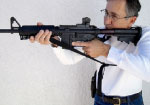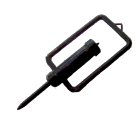Whether the problem is an armed and barricaded suspect or a terrorist hostage taker, the field supervisor is faced with the same challenges - how best to deploy his/her resources to facilitate a successful resolution to the problem. A successful outcome is a suspect taken into custody without further injury to the officers, civilian population and the suspect. The challenges presented by a critical incident require an organized and disciplined response. The containment and control actions of the first responding units and the incident commander will bring the situation to a successful conclusion. Barricaded suspects or armed suspects who barricade themselves pose extreme danger to the community as well as special tactical problems for deputies. Handling barricaded suspects safely requires special weapons, equipment and expertise which come from specialized training.
Field Supervisor Obligations during a Critical Incident
-
Contain, Control, Communicate
- It’s easy to become overwhelmed by events, prioritize what needs to be accomplished first based on the circumstances.
- As additional resources arrive, set larger perimeter and more control elements.
- Communicate who is in charge
- Active shooter-immediate response
- Officer/citizen down-requires a rescue plan
- Hostage Situation-Immediate containment to control suspect’s movement.
- Formulate a hasty rescue plan in case suspect initiates a deadly assault on victims.
- Were involved or is believed to have been involved in a serious criminal act.
- Is believed or known to be armed.
- Is believed to be a threat to the lives and safety of citizens and/or law enforcement officers.
- Is in a position of advantage, affording cover and concealment.
- Refuses to submit to arrest.
- Away from noise and confusion
- Out of the present & potential hazard
- When possible, in sight of incident
- Have the ability to grow with the incident

- Announce activation and location
- Establish safe route of approach
- If more than one agency involved follow unity of command protocols
- Establish who is in charge
- Only one commander
- Scribe
- Traffic perimeter
- Liaison with arriving units

- Assistant commander
- Media Liaison
- Be mindful that these situations can last many hours.
- Remember to care for the needs of the personnel involved.
- Tactically cover areas of possible escape.
- Avoid allowing gunman on the move, setting up an ambush from a new position.
- The goal is to contain/isolate the threat.
- Block off areas with crime scene tape.
- Stop all pedestrian and traffic flow into the area.
- Perimeter determined by type of incident and weapons involved (handgun, long rifle, etc).
- Outside of perimeter is for CP and for neighbors/pedestrians.
- Inside of tape for SWAT, CNT, and first responders until relieved by SWAT.
- Any person that you can safely get out of area, do so immediately.
- The ultimate goal is to isolate the armed subject.
- Create a safety zone for SWAT.
- If situation is too dangerous, advise citizens to stay in their homes until the incident is resolved or the police can safely remove.
- The staging area is a safe place where SWAT can suit up, get together and prepare strategy.
- Usually place close to where CP is located.
- Area should not be too far from the incident, but definitely out of the line of sight of the incident.
- If the crook can see you, they can shoot at you.
- The area should be a place to freely go over options and plan tactics in a secure environment that is large enough to accommodate personnel, vehicles, and resources.
- Talk to friends, family, and neighbors.
- Try to ascertain if the subject is really armed and what type of weapon(s) they have.
- Gather intelligence (Age, race, clothing, home/cellular phone, statements, etc.)
- Alcohol/Drugs
- Suicidal
- Medication/Mental
- Talk to Family/Friends
- Layout of Property
- Floor Plan
- Dogs
- Be ready to pass info along to SWAT
- The first officers on scene should transmit over the radio to other responding officers’ safe areas to park.
- Keep a clear path from the staging area to target property.
- Numerous types of vehicle may be moving into the area (Fire Trucks, ARV’s, Ambulances)
- It may be necessary to remove and transport injured officers, hostages, or even the suspect.
- Patrol officers are the ones that must deal with all the confusion and chaos at a scene.
- Keep crowd back and out of the way.
- SWAT has main task of dealing with the barricade/hostage/etc, while attention to any distractions is patrol’s responsibility.
- Use SMEAC (see explanation)
- Use radio and let other patrol officers know that SWAT is arriving and what role they are playing.
- Let SWAT officers know where patrol officers are positioned.
- SWAT may call on you to move people back inside their homes, out of the line of sight, or to get away from their windows.
- Your role changes.
- Maintain your command Post
- Concentrate on outer perimeter
- Assist Incident Commander as requested
- Consolidate your staff
- Return unnecessary deputies back to patrol
- Secure evidence
- Reports
- Crime
- Arrest
- Use of Force
- Deputies
- After Action
- Overtime
- Clean-up
- Command Post
- Deputy assigned areas
- Crime scene tape
- Supervise wind down of events
- Get Deputies/officers back to work
- Send Support Units back to their stations
- Debrief
- What went right?
- What went wrong?
- Ways to improve future deployments.
- Make sure everyone is involved in the debrief.
Set command post





